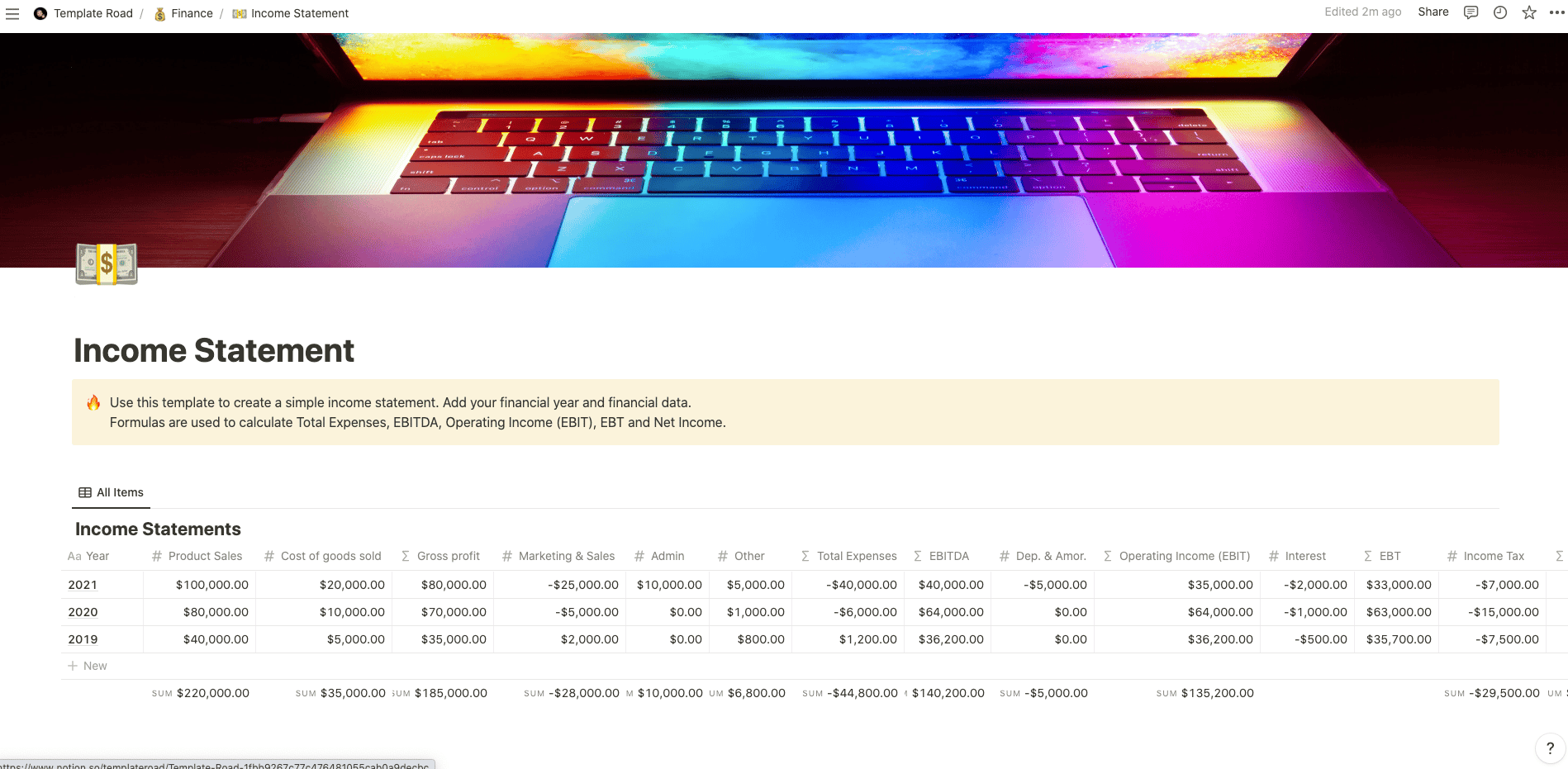Use this template to create a simple income statement.
Buy on
Contents
- Notion – Income Statement Template
- How to Write an Income Statement
- Pick a Reporting Period
- Generate a Trial Balance
- Calculate Your Revenue
- Determine Cost of Goods Sold (COGS)
- Calculate the Gross Margins
- The four types of income statements
- Single-step income statement
- Multi-step income statement
- Contribution format income statement
- Income statement vs. balance sheet: What’s the difference?
- Income statement vs. cashflow statement: What’s the difference?
Notion – Income Statement Template
Use this template to create a simple income statement in Notion. Add your financial year and financial data. Formulas are used to calculate Total Expenses, EBITDA, Operating Income (EBIT), EBT and Net Income.
——————————————-
What you need before purchase
- Basic knowledge of how to use Notion
- Paid Notion account if you want to add lots of content to your template / Notion account (sign up here). Not much content? You’re able to use their free account.
After purchase, you’ll be able to view the template immediately. The template can be added to your Notion account by:
- Click on the template download link in Gumroad
- When viewing the Notion template, click on the “Duplicate” link in the top-right of your screen
- The template will now be available in your own Notion account
How to Write an Income Statement
The six steps to writing an income statement are:
- Pick a Reporting Period
- Generate a Trial Balance Report
- Calculate Your Revenue
- Determine Cost of Goods Sold
- Calculate the Gross Margin
- Include Operating Expenses
Pick a Reporting Period
You should pick a reporting period that is long enough to show trends and short enough to be manageable. The most common reporting periods for small businesses are monthly, quarterly, and yearly. Monthly reports give you more detail than quarterly or annual reports. Quarterly reports provide information on how well your company is doing over time. Annual reports provide information about how your company performed in the past year.
Generate a Trial Balance
A trial balance report shows all the transactions between accounts within a single month. It also includes any adjustments made during the month. A trial balance report can help you spot errors and identify areas where your books need improvement.
Calculate Your Revenue
Revenue is the amount of money your customers pay you for products and services. You calculate revenue by adding up all sales from your customers. Sales include cash payments, credit card charges, checks, and other forms of payment. If you sell products online, you must add shipping costs to your total sales.
Determine Cost of Goods Sold (COGS)
COGS represents the cost of goods sold. This is the amount of money you spend to buy inventory before selling it to customers. You determine COGS by subtracting the value of inventory at the end of the accounting period from the value of inventory at beginning of the accounting period. For example, if you bought $10,000 worth of inventory at the beginning of the accounting period but only sold $8,000 worth of inventory by the end of the accounting, then you would have spent $2,000 on COGS.
Calculate the Gross Margins
Gross margins represent the difference between what you paid for inventory and what you actually received when you sold it. Gross margin is calculated as follows:
Cost of Goods Sold ÷ Revenue Gross Margin
Include Operating Expenses
Operating expenses are those items that don’t directly relate to making a profit. Examples of operating expenses include rent, utilities, insurance, payroll, advertising, and supplies. When calculating gross margins, you deduct these operating expenses from your revenues.
The four types of income statements
- Single-step income statement
- Multi-step income statement
- Common-size income statement
- Contribution format income statement
Single-step income statement
The simplest type of income statement is a single-step income statement. In this case, you simply list one line item per account. For example, here’s a single-step income report for a restaurant:
Account Name | Description | Amount
——————————————————
Sales | Total sales | $100,000
Expense
Advertising
$5,000
Rent
$15,000
———————————————————————-
Net Income
$80,000
Multi-step income statement
If you want to break down your income into several categories, you use a multi-step income statement. Here’s an example of a multi-step income report for the same restaurant:
Account Name
Description
Amount
——————————————–
Sales
Total sales
$100,000
Cost of Goods Sold
$50,000
Marketing expense
$20,000
———————————————————————
Net Profit
$30,000
Contribution format income statement
You may find it easier to read a contribution format income statement than a traditional income statement. The contribution format shows how much each part of your company contributed to your overall profits. It also provides information about which parts of your business were profitable or unprofitable.
Income statement vs. balance sheet: What’s the difference?
An income statement is a financial document that tells you how well your business did during a specific time period. A balance sheet is a financial document that shows how much money your business has in total assets and liabilities.
A balance sheet shows all the money your business owns. Assets include things like cash, accounts receivable, buildings, equipment, vehicles, furniture, and other physical property. Liabilities include debts owed to banks, suppliers, employees, landlords, and others.
An income statement shows how much money your company made during a certain time period. It includes revenue (money you receive), costs (expenses incurred to make products or services), and net income (profit). Net income is the difference between revenue and costs.
Income statement vs. cashflow statement: What’s the difference?
A cashflow statement shows what happens to your company’s cash over a particular time period. It lists all the money coming in and going out of your company.
Cashflow statements show how much money your company spent on goods and services, as well as any payments to creditors. They also tell you whether your company paid its bills on time.















